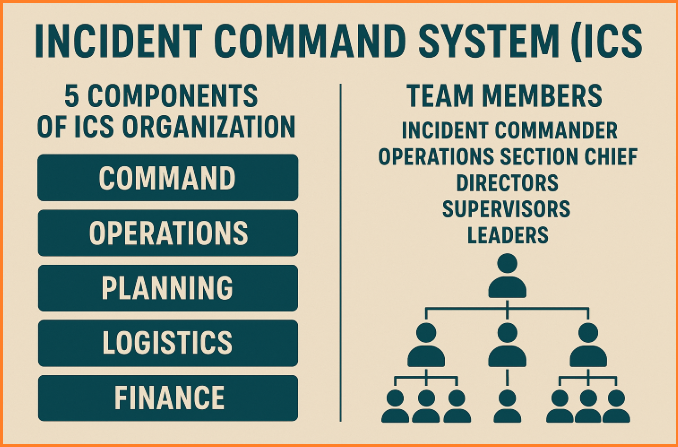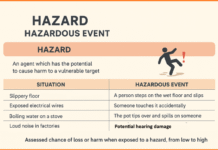The Incident Command System (ICS) is a standardized, on-scene, all-hazards incident management approach designed to allow responders from multiple agencies to work together effectively. It is used widely across public safety, emergency management, and even private industry for organizing responses to both routine and complex emergencies.
Contents
What is ICS?
The Incident Command System is a part of the National Incident Management System (NIMS), developed in the United States, and is now used globally. It provides a hierarchical structure and clear roles and responsibilities to efficiently manage emergency incidents of any type or scale—ranging from natural disasters to workplace accidents and security threats.
The 5 Major Components of ICS Organization
The ICS structure is built around five key functional areas:
1. Command
- The Command function is responsible for overall management of the incident.
- Led by the Incident Commander (IC), who sets objectives and priorities.
- May include supporting positions like Public Information Officer (PIO), Safety Officer, and Liaison Officer.
2. Operations
- Directs all tactical operations to achieve incident objectives.
- Coordinates with functional units like rescue, medical aid, and fire suppression.
- Supervised by the Operations Section Chief.
3. Planning
- Gathers and evaluates information about the incident.
- Develops action plans and provides documentation support.
- Overseen by the Planning Section Chief.
4. Logistics
- Provides resources and services to support the incident response, such as supplies, transportation, and communication systems.
- Led by the Logistics Section Chief.
5. Finance / Administration
- Manages costs, procurement, and timekeeping related to the incident.
- Critical for documenting expenditures and seeking reimbursements.
Key ICS Team Members
The strength of ICS lies in its team-based approach. Key roles include:
Incident Commander
Leads the response effort, sets overall strategy, and is the ultimate decision-maker during an incident.
Operations Section Chief
Manages all tactical response activities and directs field-level responders.
Directors
Lead specific branches or divisions within sections for better control and coordination.
Supervisors
Manage groups of similar resources, such as strike teams or task forces.
Leaders
Lead units, such as medical units, supply units, or planning teams, and ensure that their objectives are being met.
Benefits of ICS
- Scalable and Flexible: Can be expanded or contracted based on incident size.
- Efficient Communication: Promotes clear reporting relationships.
- Interoperability: Enables multiple agencies to coordinate seamlessly.
- Defined Roles: Prevents confusion and overlapping duties during chaos.
The Incident Command System is not just for firefighters or emergency responders—its principles can be applied across industries where crisis management or large-scale operations are needed. By understanding the five core components and the roles of team members, organizations can respond quickly, safely, and effectively to any incident.
Here is a Frequently Asked Questions (FAQ) section for the Incident Command System (ICS):
Incident Command System (ICS) – FAQ
1. What is the Incident Command System (ICS)?
ICS is a standardized, flexible, and scalable emergency response framework used to manage incidents of any size or type. It ensures coordinated and efficient operations across multiple agencies.
2. Why is ICS important?
ICS provides clear roles, responsibilities, and structure, improving communication, reducing confusion, and enhancing safety during emergency responses.
3. Who uses ICS?
ICS is used by:
- Emergency responders (fire, police, EMS)
- Government agencies
- Industrial safety teams
- Hospitals
- Event planners
- Schools and universities
- Private sector companies
4. What are the five major components of ICS?
- Command – Overall incident management
- Operations – Tactical response efforts
- Planning – Information collection and incident planning
- Logistics – Resource and support management
- Finance/Administration – Cost tracking and administrative support
5. Who are the key personnel in an ICS team?
- Incident Commander
- Operations Section Chief
- Directors (for branches)
- Supervisors (for divisions/groups)
- Leaders (for units or strike teams)
6. Can ICS be used for non-emergency situations?
Yes. ICS is also used in planned events like concerts, sports events, and festivals to ensure safety, resource coordination, and emergency preparedness.
7. Is ICS scalable for small incidents?
Absolutely. ICS can be scaled down for small workplace incidents and scaled up for large-scale disasters, making it highly adaptable.
8. What training is required for ICS?
Common ICS training includes:
- ICS 100: Introduction to ICS
- ICS 200: Basic ICS for Initial Response
- ICS 300 & 400: For complex incident management
- NIMS-compliant courses
9. How does ICS differ from traditional management systems?
ICS is incident-specific, hierarchical, and modular, unlike regular business management systems. It emphasizes operational efficiency, safety, and inter-agency coordination under emergency conditions.
10. Who is in charge during an ICS operation?
The Incident Commander is in charge and responsible for setting objectives, managing operations, and coordinating with all involved agencies or teams.






Nice, thanks
Thank You!!